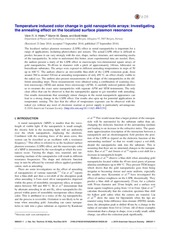| dc.rights.license | This article may be downloaded for personal use only. Any other use requires prior permission of the author and AIP Publishing. | en_US |
| dc.contributor.author | Holm, Vårin Renate Andvik | |
| dc.contributor.author | Greve, Martin Møller | |
| dc.contributor.author | Holst, Bodil | |
| dc.date.accessioned | 2018-05-29T07:14:25Z | |
| dc.date.available | 2018-05-29T07:14:25Z | |
| dc.date.issued | 2016 | |
| dc.identifier.issn | 2166-2746 | en_US |
| dc.identifier.uri | https://hdl.handle.net/1956/17730 | |
| dc.description.abstract | The localized surface plasmon resonance (LSPR) effect in metal nanoparticles is important for a range of applications, including photovoltaics and sensors. The actual LSPR effect is difficult to predict, because it can vary strongly with the size, shape, surface structure, and surrounding media of the nanoparticles. In order to understand this better, more experimental data are needed. Here, the authors present a study of the LSPR effect in macroscopic two-dimensional square arrays of gold nanoparticles, 50–80 nm in diameter with a pitch of approximately 160 nm, fabricated on borosilicate substrates. The arrays were exposed to different annealing temperatures in steps of 50 up to 600 °C. The authors observe an irreversible blue-shift of the LSPR extinction peak, from around 580 to around 520 nm at annealing temperatures of only 450 °C, an effect clearly visible to the naked eye. The authors also present measurements of the shape of the nanoparticles at the different annealing steps. These measurements were obtained using a combination of scanning electron microscopy (SEM) and atomic force microscopy (AFM). A carefully indexed pattern allowed us to measure the exact same nanoparticles with separate AFM and SEM instruments. The only clear effect that can be observed is that the nanoparticles appear to get smoother with annealing. Our results demonstrate that seemingly minor changes in the metal nanoparticle appearance can lead to a strong change in the LSPR effect. Our results also open up for potential applications in temperature sensing. The fact that the effect of temperature exposure can be observed with the naked eye without any need of electronic readout or power supply is particularly advantageous. | en_US |
| dc.language.iso | eng | eng |
| dc.publisher | AIP Publishing | en_US |
| dc.relation.ispartof | <a href="http://hdl.handle.net/1956/17732" target="_blank">Nanostructured Materials for Solar Energy Applications</a> | en_US |
| dc.title | Temperature induced color change in gold nanoparticle arrays: Investigating the annealing effect on the localized surface plasmon resonance | en_US |
| dc.type | Peer reviewed | |
| dc.type | Journal article | |
| dc.description.version | publishedVersion | en_US |
| dc.rights.holder | Copyright 2016 American Vacuum Society. | en_US |
| dc.source.articlenumber | 06K501 | |
| dc.identifier.doi | https://doi.org/10.1116/1.4963153 | |
| dc.identifier.cristin | 1410399 | |
| dc.source.journal | Journal of Vacuum Science & Technology B | |
| dc.source.40 | 34 | |
